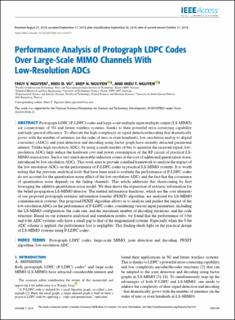| dc.contributor.author | Nguyen, Thuy V. | |
| dc.contributor.author | Vu, Hieu D. | |
| dc.contributor.author | Nguyen, Diep N. | |
| dc.contributor.author | Nguyen, Hieu | |
| dc.date.accessioned | 2020-07-01T12:40:18Z | |
| dc.date.available | 2020-07-01T12:40:18Z | |
| dc.date.created | 2020-01-24T09:51:41Z | |
| dc.date.issued | 2019 | |
| dc.identifier.citation | Nguyen, T. V., Vu, H. D., Nguyen, D. N., & Nguyen, H. T. (2019). Performance Analysis of Protograph LDPC Codes Over Large-Scale MIMO Channels With Low-Resolution ADCs. IEEE Access, 7, 145145-145160. doi:10.1109/ACCESS.2019.2944567 | en_US |
| dc.identifier.issn | 2169-3536 | |
| dc.identifier.uri | https://hdl.handle.net/11250/2660357 | |
| dc.description.abstract | Protograph LDPC (P-LDPC) codes and large-scale multiple-input multiple-output (LS-MIMO) are cornerstones of 5G and future wireless systems, thanks to their powerful error-correcting capability and high spectral efficiency. To alleviate the high complexity in signal detection/decoding that dramatically grows with the number of antennas (in the order of tens or even hundreds), low-resolution analog-to-digital converters (ADCs) and joint detection and decoding using factor graph have recently attracted paramount interest. Unlike high-resolution ADCs, by using a small number of bits to quantize the received signal, low-resolution ADCs help reduce the hardware cost and power consumption of the RF circuit of practical LS-MIMO transceivers. Such a very much desirable reduction comes at the cost of additional quantization noise, introduced by low-resolution ADCs. This work aims to provide a unified framework to analyze the impact of the low-resolution ADCs on the performance of P-LDPC codes in practical LS-MIMO systems. It is worth noting that the previous analytical tools that have been used to evaluate the performance of P-LDPC codes do not account for the quantization noise effect of the low-resolution ADCs and the fact that the covariance of quantization noise depends on the fading channels. This article addresses this shortcoming by first leveraging the additive quantization noise model. We then derive the expression of extrinsic information for the belief-propagation LS-MIMO detector. The mutual information functions, which are the core elements of our proposed protograph extrinsic information transfer (PEXIT) algorithm, are analyzed for LS-MIMO communication systems. Our proposed PEXIT algorithm allows us to analyze and predict the impact of the low-resolution ADCs on the performance of P-LDPC codes, considering various input parameters, including the LS-MIMO configuration, the code rate, and the maximum number of decoding iterations, and the code structure. Based on our extensive analytical and simulation results, we found that the performance of 3-bit and 4-bit ADC systems only have a small gap to that of the unquantized systems. Especially when the 5-bit ADC scheme is applied, the performance loss is negligible. This finding sheds light on the practical design of LS-MIMO systems using P-LDPC codes. | en_US |
| dc.language.iso | eng | en_US |
| dc.rights | Navngivelse 4.0 Internasjonal | * |
| dc.rights.uri | http://creativecommons.org/licenses/by/4.0/deed.no | * |
| dc.title | Performance Analysis of Protograph LDPC Codes Over Large-Scale MIMO Channels With Low-Resolution ADCs | en_US |
| dc.type | Peer reviewed | en_US |
| dc.type | Journal article | en_US |
| dc.description.version | publishedVersion | en_US |
| dc.source.pagenumber | 145145-145160 | en_US |
| dc.source.volume | 7 | en_US |
| dc.source.journal | IEEE Access | en_US |
| dc.identifier.cristin | 1781309 | |
| cristin.ispublished | true | |
| cristin.fulltext | original | |
| cristin.qualitycode | 1 | |

